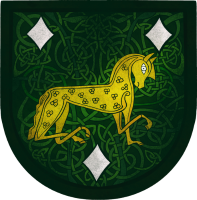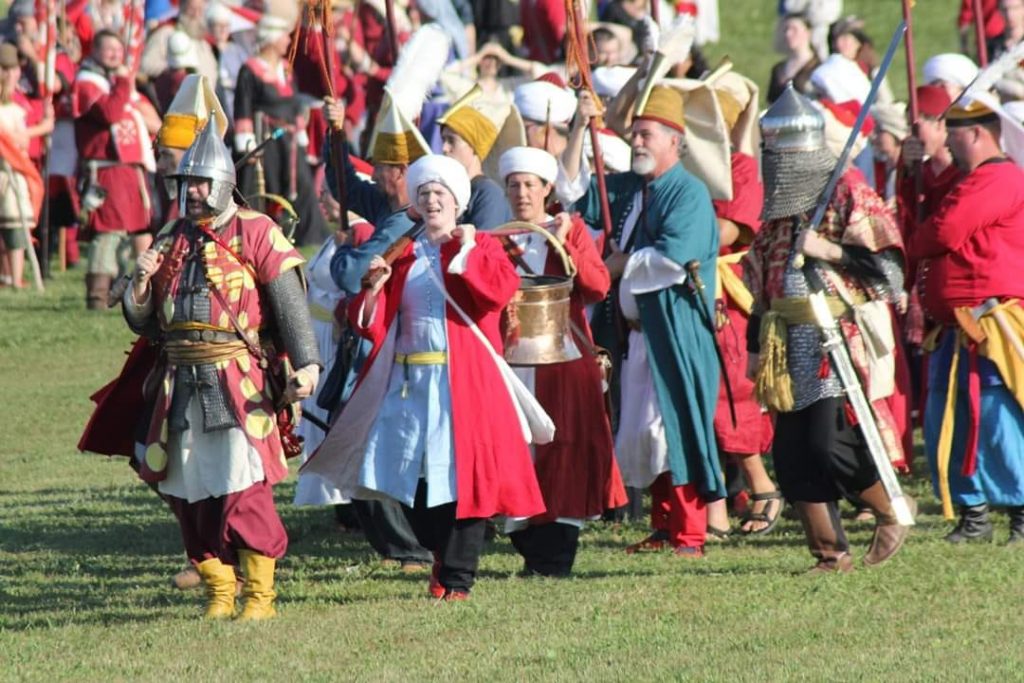
For the second year in a row, I was proud to be a member of the Ottoman Mehter Takımı, or Janissary Band, at Pennsic. I was also asked to put together a display of the band’s material culture for the Known World A&S Display. I enjoyed coordinating it, and writing the materials allowed me to learn even more about the Mehteran! In this post, I’ve included photographs of the display and of my new uniform. After the cut is the display’s sign text.
Many thanks to Maggie Hays for the photos of the display below. It was rather hard to photograph, as it was long (two tables!) and tall (standards and flags!).
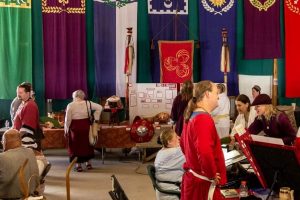
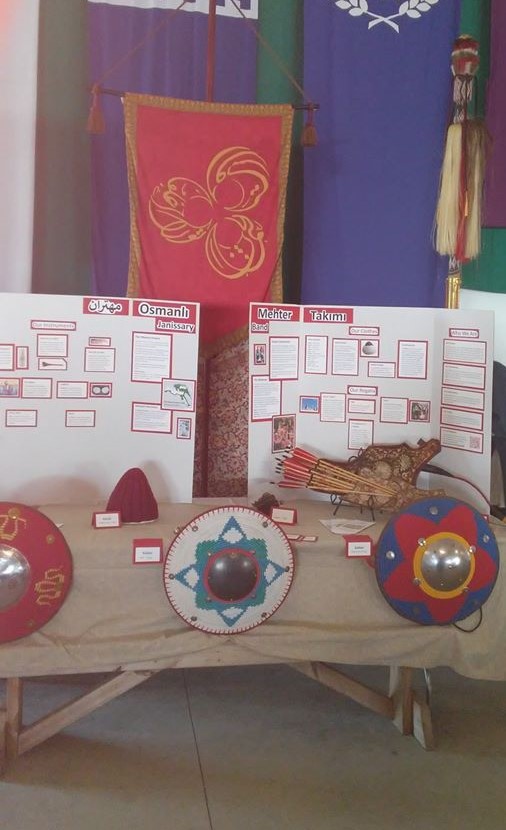
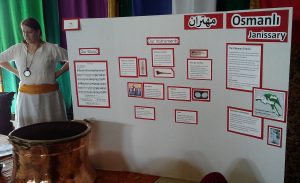
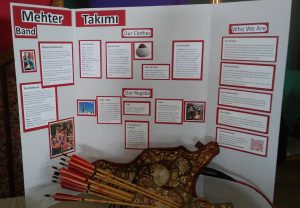
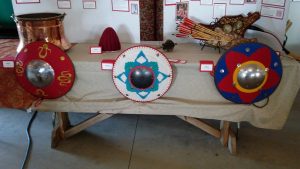
For my efforts in the A&S display, I was named an onbaşı (corporal) in September 2019.
As part of my individual efforts, I made a new uniform that was much more accurate than the one I wore in 2018.
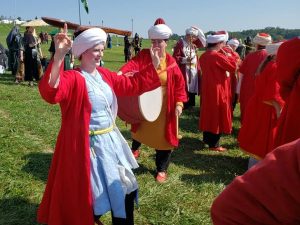
For my new uniform, I made a new red coat, kaftan, pants, turban, and cross-body bag. Because I was making these close to Pennsic, most items were machine-sewn; however, I hand-finished the coat. I also made some prayer beads as an accessory to hang from my sash (and fiddle with while we were waiting to march!). I’m really happy with my uniform now, but for the next march I plan to update my hat (time for a historically accurate one — read below!) and my yellow sash (it’s just too flimsy.)
Keep reading for the text from the display!
Mehteran A&S Display, Pennsic 2019
Contents
- The Ottoman Empire
- Yeniçeri (Janissaries)
- Bektashi Dervishes
- The Mehteran
- Our Purpose
- Our Collaborations
- Our Membership
- Join the Mehteran
The Ottoman Empire
Founded by Osman I in 1299, the Ottoman Empire lasted until 1922. Over 150 years, the Empire conquered modern-day Turkey, Greece, and the Balkans.
Under Mehmed II the Conqueror, Constantinople (Istanbul) was finally captured on 29 May 1453. Suleiman the Magnificent laid siege to Vienna in 1529, but it did not fall.
Under Suleiman, the Empire allied with France. During the reign of Murad II, the Empire established diplomatic relations with England.
By 1600, the Empire stretched from Iraq to Algeria and from Yemen to Hungary, connecting Asia, Africa, and Europe.
Significant Reigns
Mehmed II the Conqueror, b. 1432, r. 1444-1446 and 1451-1481
Suleiman I the Magnificent, b. 1494, r. 1520-1566
Murad II, b. 1546, r. 1574-1595
Yeniçeri (Janissaries)
Formed in the late 1300s, the yeniçeri (“new soldiers”) were the Ottoman Sultan’s personal infantry. They lived in Topkapı Saray (Palace) in Istanbul. The infantry were their family, with the Sultan serving as their “father.”
During our period, yeniçeri were selected from Orthodox Christian families at a young age. While this required conversion to Islam, their families were often pleased: yeniçeri could achieve elite status in the Empire.
The corps itself was organized around the concept of the kitchen. For example, a high-ranking commander would be called çorbacı (soup-maker).
While dedicated to the Sultan, the yeniçeri were only one force. His army could also include other infantry, cavalry, and artillery.
The Equipment of a Yeniçeri
The kalkan (shield) is made of rattan wrapped in thread. Yeniçeri also bore a variety of weapons, which could include a yatagan (sword), dagger, axe, or bow with bowcase. By the 15th century yeniçeri started to use matchlock muskets, fully adopted by the 16th century.
Bektashi Dervishes
The Bektashi dervishes are a mystic religious fraternity in the Sufi tradition of Islam. Formed in 1501, they were charged with caring for yeniçeri both physically and spiritually. For this reason, they also cared for the Mehteran in Topkapı Saray.
While bektashi dervishes dance, the “whirling” dance associated with Turkish dervish orders is practiced by the Mevlevi order, not the Bektashi order.
The Mehteran
Drawn from the same background as yeniçeri, the mehteran are a military marching band. Their musical tradition dates back to the earliest years of the empire. At the latest, organized mehteranlar began with Mehmed the Conqueror. As such, the mehteran is likely the origin of marching bands.
During our period, the band was stationed in the Enderun (palace school for yeniçeri) of Topkapı Saray. They accompanied the yeniçeri on campaign. As a military band, it is comprised of squadrons of instruments. Each squadron has its own leader.
Terminology
Mehter: One band member
Mehteran: the whole band
Mehterhane: the band when serving in a royal retinue
Mehter Takımı: a platoon of mehter
What We Wear
Kaftan – mehter coat
Kontuş – yeniçeri coat
Zibin – cavalry coat
Dolama – inner robe
Şalvar – pants
Gömlek – undergarment
Kavuk ve Sarık – hat and turban
Börk – yeniçeri hat
Kuşak – sash
Çizme (Edik) – boots
Yemeni – shoes
Khuff – leather socks
Based on the research of Dr. Fatih Köse, PhD, Ottoman studies, Sivas, Turkey
Kavuk & Sarık
Rank in the Ottoman Empire was designated through one’s headgear, which was regulated by sumptuary laws. Each Mehter wears the kavuk (padded conical hat), which is a base for the sarık (turban). The turban is made out of folded cloth approximately 15 yards long.
Instead of the kavuk and sarık, yeniçeri wear a börk. Modeled on the “sleeve of the prophet,” this hat has a plume-holder with a ceremonial spoon.
Kaftan & Kuşak
The red coat and yellow sash are the uniform of the Mehteran. These garments distinguish members from the yeniçeri and the general populace.
Everything Else!
The dolama is the coat that Mehter and yeniçeri wear beneath their official coat. Beneath the dolama, they were a gömlek (undergarment), şalvar (pants), and yemeni (shoes) or çizme (boots). They might where khuff (leather socks) with their yemeni or çizme. When marching, officers wear yellow yemeni or çizme, while regular members have red footwear. Because the dolama and şalvar are a Mehter’s everyday clothes, they can be any color or pattern fitting their rank.
Regalia
Kazan
The sacred cauldron or soup pot is a symbol of the communality and connection of the yeniçeri to the Sultan. When the yeniçeri decided to revolt, they would up-end the kazan and beat it with the ladle. To this day, “kazan kaldırmak” (raising the cauldron) means to start a revolt in Turkish.
Tuğ (pl. Tuğlar)
The tuğ is a horsetail standard carried by yeniçeri. While the kazan was the symbol of the yeniçeri, the tuğlar represented the military leader present. The number of tuğlar indicated their rank.
Our tuğlar our composite copies from a 17th-century artifact from the Siege of Vienna (c. 1683) and the Vienna City Museum, The National Collection of Wawel Castle in Krakow, The National Museum in Budapest, The Turkische Cammer in Dresden, and Topkapı Palace, created by Osman Usta, our Mehterbaşı.
Flag
The Ottoman battle flag is a digital recreation of an extant flag from period by mehter Kharajin.
Instruments
Cevgen (pl. Cevgenler)
The cevgen, also called bell staffs or Jingling Johnny, are percussion instruments carried by the singers. The singers themselves are considered an instrumental unit within the mehteran.
Zurna (pl. Zurnalar)
The zurna is a reed instrument similar to an oboe or European shawm. They give the mehteran its unique sound. Kaba zurna (long) are authentic to the mehteran, while cura zurna (short) are more common.
Boru (pl. Borular)
Boru are the traditional brass of the mehteran similar to a trumpet. Mehter and Borubaşı Goffredo Pico dell’Aquila has researched and recreated authentic borular for our mehteran. Modern brass instruments fill out the ranks.
Kos Takimi
The kos takimi is the kettledrum team. Comprised of one player, two kettledrums, and two strong recruits, the kos takimi is one of the loudest and flashiest parts of the mehter.
Zil (pl. Zillar)
Zillar is Turkish for cymbals! The brightness of the giant hand-held zillar fill out the percussion of the mehteran.
Nakkare
Nakkare are a paired drum with a round back and a hide head. Held cradled in the crook of the elbow, nakkare are played with two sticks.
Davul
The davul is a large double-headed drum carried by a single mehter. The player uses two sticks of different size, one on each side of the drum.
Our Purpose
The Osmanlı Mehter Takımı is dedicated to the study and interpretation of the music and history of the Ottoman Mehter Janissary military marching band from the 14th to 17th centuries under the direction of Osman Usta. Our group is focused on the 16th-century period of the Golden Age of the Ottoman Empire. However, we draw upon the surviving material culture of the Turkish Booty, from the Siege of Vienna, circa 1683.
Our Collaborations
The Osmanlı Mehter Takımı has kindly allied with Ordugah: Türk Tarihi Canlandırma Ekibi (The Turkish Historical Reenactment Team) of Turkey. We gratefully acknowledge the help of Fatih Paşa and Ordugah in our ongoing recreations.
Our Membership
As in the Ottoman Empire, the Mehteran draws from across the Kingdoms of the SCA. Current membership includes members from Æthelmearc, Ansteorra, Atlantia, Ealdormere, the East, Gleann Abhann, Meridies, the Middle, Trimaris, and the West. Members of the Mehteran include veterans of the original Janissary Band (Pennsic 25-27) as well as new recruits.
Join the Mehteran
Serve the Sultan, See the World. Amaze your friends and make new ones. Enlistment includes soup and baklava ceremonies. Anatolian retirement packages available.
